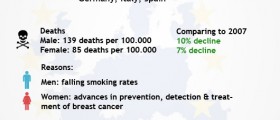
Increasing Fertility Chances
Fertility corresponds to the ability to conceive and have offspring. Whether a couple will be able to have children depends on numerous factors such as the overall health, nutrition, sexual behavior, financial ability, and so on. Fertility rate refers to a number of children produced by couples within a population, and it is measured either through period or cohort methods. The period method involves a cross-section of a given population during a one year period, while the cohort method collects longitudinal data by following the same couples for decades. Places where there are 10 to 20 births per 1,000 women are considered to have low birth rate, whereas 40 to 50 births per 1,000 women are viewed as a high natality rate. Various countries have different problems ranging from exceptionally high to exceptionally low birth rates. High birth rate puts a strain on the government to provide youth welfare and family programs, education, jobs, and a sustainable environment. On the other hand, low birth rates create problems for the governments when it comes to senior welfare programs. The less people there are in the workforce the harder it is to support the aging population. In addition, many governments are concerned with birth rate, especially in the countries where the mortality is higher than natality. Countries like Italy and Malaysia provide incentives such as financial assistance and support services for new mothers. On the other hand, China has a policy aimed at reducing the birth rate. In overpopulated countries availability of information about birth control methods proved to be successful in reducing the birth rate. Such places have also been focusing on bettering the women’s sexual health and reproductive rights. As women are becoming more educated and skill-trained in the developing world the birth rate is expected to decline. There have been many international conferences where representatives from the developing countries have met to discuss ways of introducing proper birth control methods and decreasing both the birth rate and high rates of abortion.
Life Expectancy and Birth Rate in Estonia
Life expectancy refers to a statistical number of years a person is expected to live, and it depends on various elements. For instance, parents who are smoking, have weight problems, and high blood pressure are likely to have children whose life expectancy will be shorter than that of the parents who are generally healthy. Socioeconomic status also plays a major role in determining life expectancy, where financially stable individuals are expected to live longer than those of fewer financial means. Furthermore, individuals living in the transitioning economies of Easter Europe have a very low life expectancy. Estonia is characterized by the lowest statistical life expectancy in the region. There is also a high incidence of abortions in Estonia due to lack of knowledge about relatively easily accessible birth control methods. As a result, many women opt for abortion as their primary contraceptive measure. Also, more than 90 percent of first born children are conceived outside of marriage while about half are born outside of wedlock. Interestingly, only about 10 percent of children are born into a family without a father, which is about the same as in other neighboring Nordic countries. This tendency is even in decline among young individuals. On the other hand, an average woman living in modern day Estonia gives birth to her children far later than her counterpart living in pre-WWII Estonia. Similarly, during the seventies an average age for the first child was around 23 while today only about 30 percent of women have a child by the same age.
Birth Rate Statistics
Birth rate is computed by taking the number of live births from the registration of births, deaths, marriages, and population counts. Birth rate is integrated with death and migration rates in order to estimate the population growth. When the number of childbirth per 1,000 individuals in one year is subtracted from the number of deaths within a population over the same time period the given number reveals the rate of natural increase or decrease. The given number, or the crude birth rate, also discloses changes in the population not including migration. Another statistic which often yields useful information when talking about birth rates is the age-specific rate which corresponds to the number of births in the same age group. However, the most often used statistic when estimating fertility and birth rate is the crude birth rate, or the number of births per 1,000 individuals within a population. Another indicator of fertility which is fairly often employed is the average number of children a woman has in her lifetime. Regardless of whether the data is dealing with a younger or an aging population, the total fertility rate is often a better indicator of birth rate than the crude birth rate. Not surprisingly, women who live in the developing countries tend to have more children on average compared to women living in the developed world.

















Your thoughts on this
Loading...